Implementation of AIS/ERP Systems in Public Transport Victoria: Report
VerifiedAdded on 2020/04/07
|20
|4757
|45
Report
AI Summary
This report investigates the implementation of Accounting Information System (AIS) and Enterprise Resource Planning (ERP) systems within Public Transport Victoria (PTV). It begins with an executive summary and introduction, outlining the benefits of integrating ERP into the existing system. The report delves into the current business processes of PTV and the advantages of ERP, including improved efficiency, accuracy, and customer service through features like customer portals, schedule maintenance, and real-time tracking. It then details the business and system requirements for successful implementation, encompassing operational planning, transportation intelligence, fleet management, and freight payment. Software and vendor selection are also discussed, with recommendations for compatible software and vendor solutions, including considerations for compatibility, record tracking, financial stability, and stakeholder interaction. The report further explores the potential security risks and data breaches associated with ERP implementation and proposes mitigation strategies. The conclusion summarizes the key findings and implications for PTV, emphasizing the benefits of the implementation. The report is a detailed analysis of AIS/ERP implementation for PTV and provides a comprehensive overview of the critical aspects of the project.
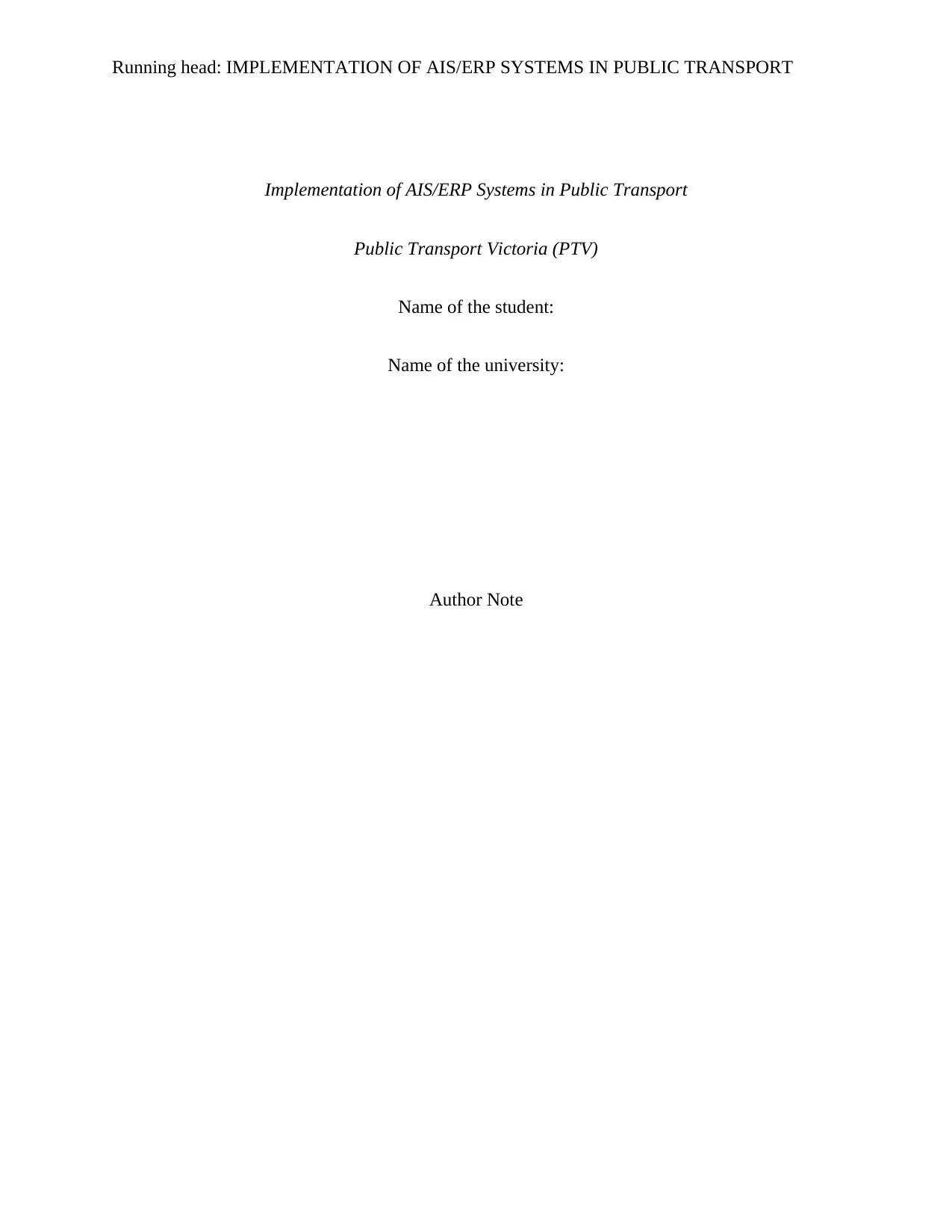
Running head: IMPLEMENTATION OF AIS/ERP SYSTEMS IN PUBLIC TRANSPORT
Implementation of AIS/ERP Systems in Public Transport
Public Transport Victoria (PTV)
Name of the student:
Name of the university:
Author Note
Implementation of AIS/ERP Systems in Public Transport
Public Transport Victoria (PTV)
Name of the student:
Name of the university:
Author Note
Paraphrase This Document
Need a fresh take? Get an instant paraphrase of this document with our AI Paraphraser
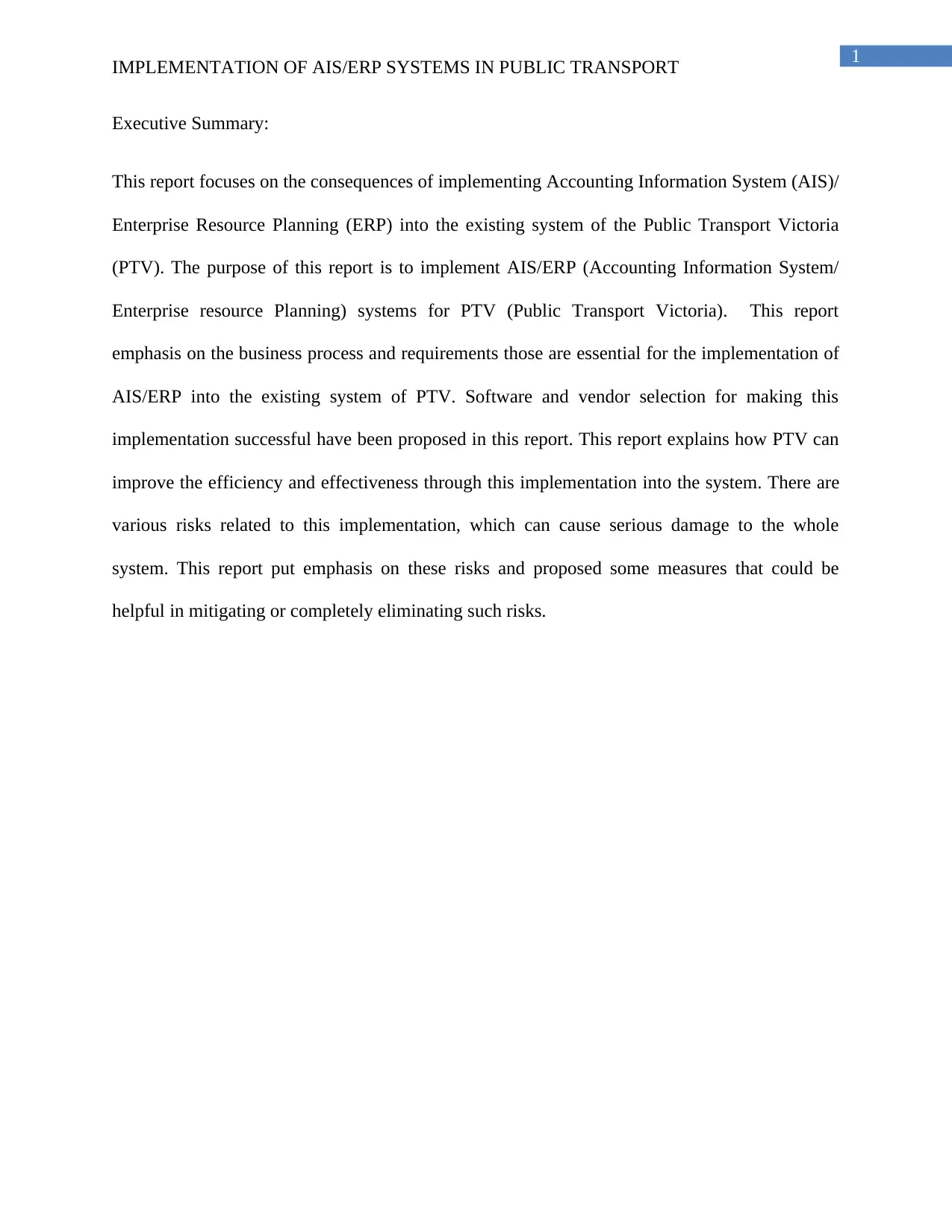
1
IMPLEMENTATION OF AIS/ERP SYSTEMS IN PUBLIC TRANSPORT
Executive Summary:
This report focuses on the consequences of implementing Accounting Information System (AIS)/
Enterprise Resource Planning (ERP) into the existing system of the Public Transport Victoria
(PTV). The purpose of this report is to implement AIS/ERP (Accounting Information System/
Enterprise resource Planning) systems for PTV (Public Transport Victoria). This report
emphasis on the business process and requirements those are essential for the implementation of
AIS/ERP into the existing system of PTV. Software and vendor selection for making this
implementation successful have been proposed in this report. This report explains how PTV can
improve the efficiency and effectiveness through this implementation into the system. There are
various risks related to this implementation, which can cause serious damage to the whole
system. This report put emphasis on these risks and proposed some measures that could be
helpful in mitigating or completely eliminating such risks.
IMPLEMENTATION OF AIS/ERP SYSTEMS IN PUBLIC TRANSPORT
Executive Summary:
This report focuses on the consequences of implementing Accounting Information System (AIS)/
Enterprise Resource Planning (ERP) into the existing system of the Public Transport Victoria
(PTV). The purpose of this report is to implement AIS/ERP (Accounting Information System/
Enterprise resource Planning) systems for PTV (Public Transport Victoria). This report
emphasis on the business process and requirements those are essential for the implementation of
AIS/ERP into the existing system of PTV. Software and vendor selection for making this
implementation successful have been proposed in this report. This report explains how PTV can
improve the efficiency and effectiveness through this implementation into the system. There are
various risks related to this implementation, which can cause serious damage to the whole
system. This report put emphasis on these risks and proposed some measures that could be
helpful in mitigating or completely eliminating such risks.
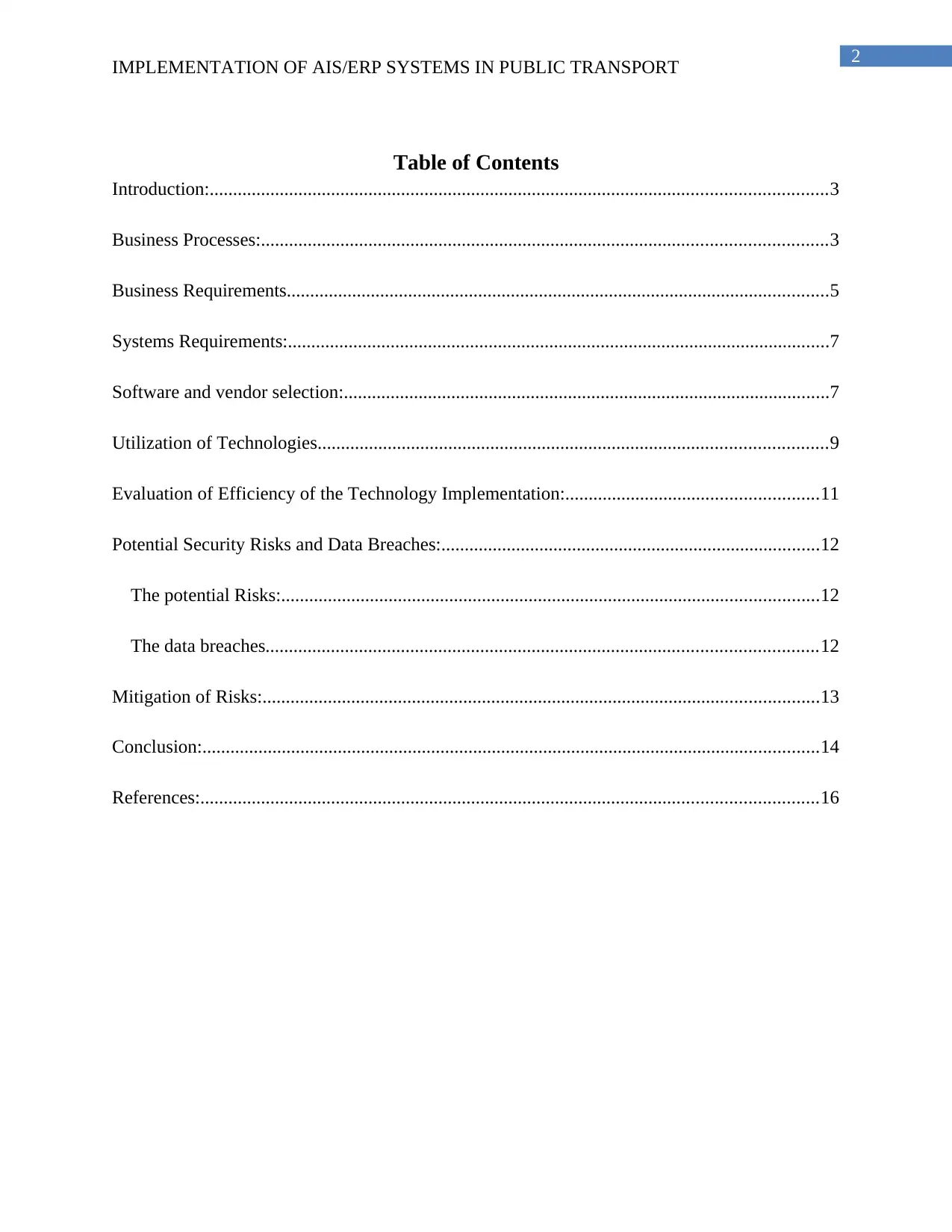
2
IMPLEMENTATION OF AIS/ERP SYSTEMS IN PUBLIC TRANSPORT
Table of Contents
Introduction:....................................................................................................................................3
Business Processes:.........................................................................................................................3
Business Requirements....................................................................................................................5
Systems Requirements:....................................................................................................................7
Software and vendor selection:........................................................................................................7
Utilization of Technologies.............................................................................................................9
Evaluation of Efficiency of the Technology Implementation:......................................................11
Potential Security Risks and Data Breaches:.................................................................................12
The potential Risks:...................................................................................................................12
The data breaches......................................................................................................................12
Mitigation of Risks:.......................................................................................................................13
Conclusion:....................................................................................................................................14
References:....................................................................................................................................16
IMPLEMENTATION OF AIS/ERP SYSTEMS IN PUBLIC TRANSPORT
Table of Contents
Introduction:....................................................................................................................................3
Business Processes:.........................................................................................................................3
Business Requirements....................................................................................................................5
Systems Requirements:....................................................................................................................7
Software and vendor selection:........................................................................................................7
Utilization of Technologies.............................................................................................................9
Evaluation of Efficiency of the Technology Implementation:......................................................11
Potential Security Risks and Data Breaches:.................................................................................12
The potential Risks:...................................................................................................................12
The data breaches......................................................................................................................12
Mitigation of Risks:.......................................................................................................................13
Conclusion:....................................................................................................................................14
References:....................................................................................................................................16
⊘ This is a preview!⊘
Do you want full access?
Subscribe today to unlock all pages.

Trusted by 1+ million students worldwide
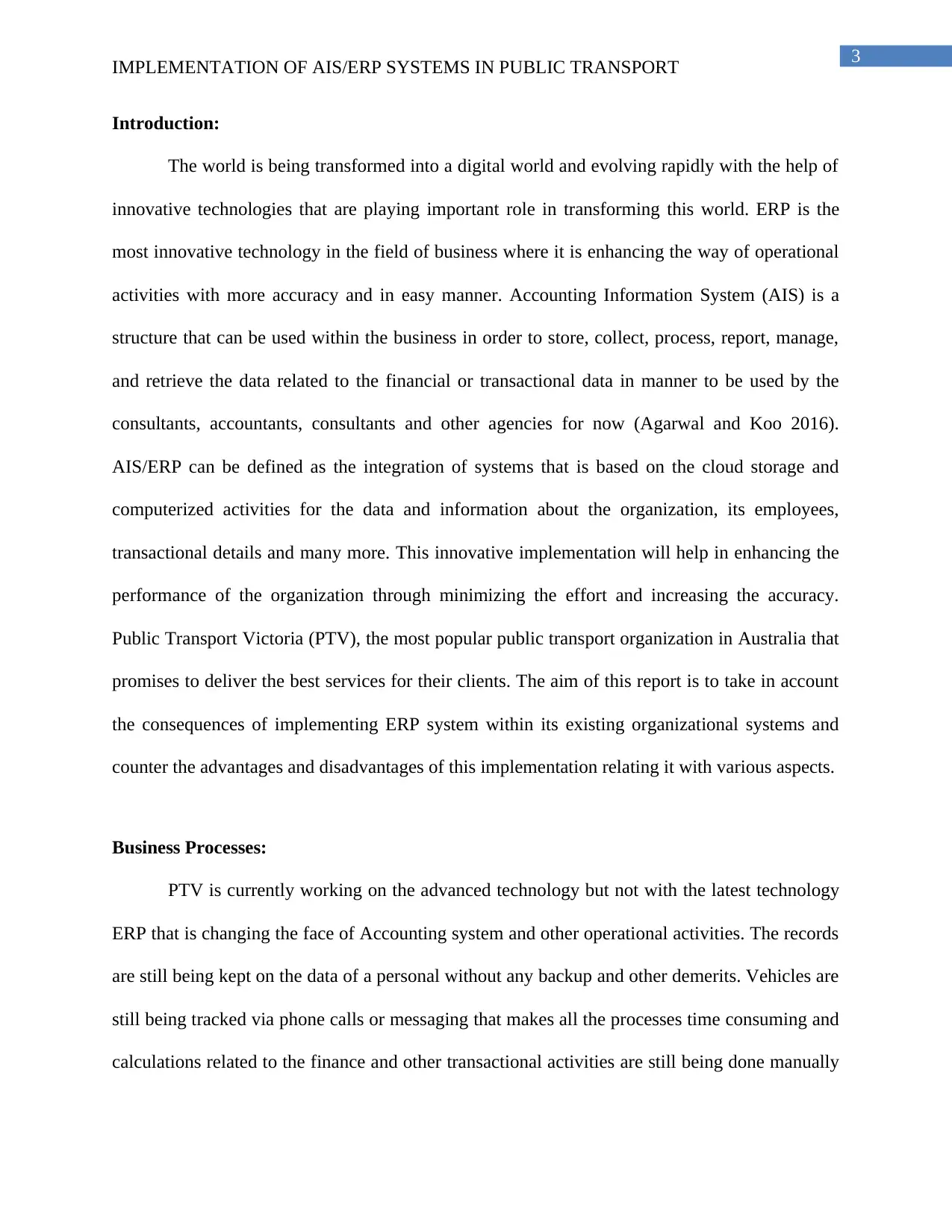
3
IMPLEMENTATION OF AIS/ERP SYSTEMS IN PUBLIC TRANSPORT
Introduction:
The world is being transformed into a digital world and evolving rapidly with the help of
innovative technologies that are playing important role in transforming this world. ERP is the
most innovative technology in the field of business where it is enhancing the way of operational
activities with more accuracy and in easy manner. Accounting Information System (AIS) is a
structure that can be used within the business in order to store, collect, process, report, manage,
and retrieve the data related to the financial or transactional data in manner to be used by the
consultants, accountants, consultants and other agencies for now (Agarwal and Koo 2016).
AIS/ERP can be defined as the integration of systems that is based on the cloud storage and
computerized activities for the data and information about the organization, its employees,
transactional details and many more. This innovative implementation will help in enhancing the
performance of the organization through minimizing the effort and increasing the accuracy.
Public Transport Victoria (PTV), the most popular public transport organization in Australia that
promises to deliver the best services for their clients. The aim of this report is to take in account
the consequences of implementing ERP system within its existing organizational systems and
counter the advantages and disadvantages of this implementation relating it with various aspects.
Business Processes:
PTV is currently working on the advanced technology but not with the latest technology
ERP that is changing the face of Accounting system and other operational activities. The records
are still being kept on the data of a personal without any backup and other demerits. Vehicles are
still being tracked via phone calls or messaging that makes all the processes time consuming and
calculations related to the finance and other transactional activities are still being done manually
IMPLEMENTATION OF AIS/ERP SYSTEMS IN PUBLIC TRANSPORT
Introduction:
The world is being transformed into a digital world and evolving rapidly with the help of
innovative technologies that are playing important role in transforming this world. ERP is the
most innovative technology in the field of business where it is enhancing the way of operational
activities with more accuracy and in easy manner. Accounting Information System (AIS) is a
structure that can be used within the business in order to store, collect, process, report, manage,
and retrieve the data related to the financial or transactional data in manner to be used by the
consultants, accountants, consultants and other agencies for now (Agarwal and Koo 2016).
AIS/ERP can be defined as the integration of systems that is based on the cloud storage and
computerized activities for the data and information about the organization, its employees,
transactional details and many more. This innovative implementation will help in enhancing the
performance of the organization through minimizing the effort and increasing the accuracy.
Public Transport Victoria (PTV), the most popular public transport organization in Australia that
promises to deliver the best services for their clients. The aim of this report is to take in account
the consequences of implementing ERP system within its existing organizational systems and
counter the advantages and disadvantages of this implementation relating it with various aspects.
Business Processes:
PTV is currently working on the advanced technology but not with the latest technology
ERP that is changing the face of Accounting system and other operational activities. The records
are still being kept on the data of a personal without any backup and other demerits. Vehicles are
still being tracked via phone calls or messaging that makes all the processes time consuming and
calculations related to the finance and other transactional activities are still being done manually
Paraphrase This Document
Need a fresh take? Get an instant paraphrase of this document with our AI Paraphraser
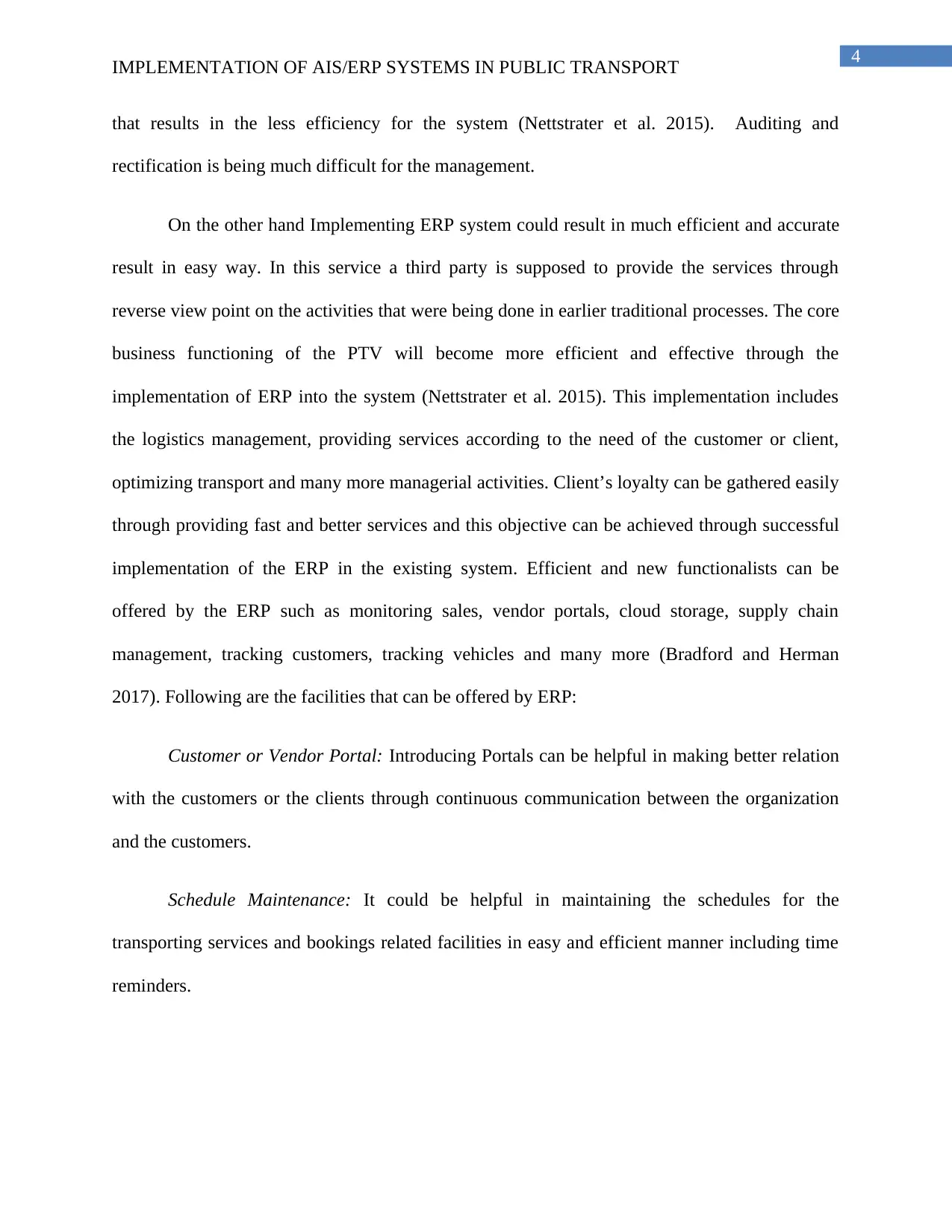
4
IMPLEMENTATION OF AIS/ERP SYSTEMS IN PUBLIC TRANSPORT
that results in the less efficiency for the system (Nettstrater et al. 2015). Auditing and
rectification is being much difficult for the management.
On the other hand Implementing ERP system could result in much efficient and accurate
result in easy way. In this service a third party is supposed to provide the services through
reverse view point on the activities that were being done in earlier traditional processes. The core
business functioning of the PTV will become more efficient and effective through the
implementation of ERP into the system (Nettstrater et al. 2015). This implementation includes
the logistics management, providing services according to the need of the customer or client,
optimizing transport and many more managerial activities. Client’s loyalty can be gathered easily
through providing fast and better services and this objective can be achieved through successful
implementation of the ERP in the existing system. Efficient and new functionalists can be
offered by the ERP such as monitoring sales, vendor portals, cloud storage, supply chain
management, tracking customers, tracking vehicles and many more (Bradford and Herman
2017). Following are the facilities that can be offered by ERP:
Customer or Vendor Portal: Introducing Portals can be helpful in making better relation
with the customers or the clients through continuous communication between the organization
and the customers.
Schedule Maintenance: It could be helpful in maintaining the schedules for the
transporting services and bookings related facilities in easy and efficient manner including time
reminders.
IMPLEMENTATION OF AIS/ERP SYSTEMS IN PUBLIC TRANSPORT
that results in the less efficiency for the system (Nettstrater et al. 2015). Auditing and
rectification is being much difficult for the management.
On the other hand Implementing ERP system could result in much efficient and accurate
result in easy way. In this service a third party is supposed to provide the services through
reverse view point on the activities that were being done in earlier traditional processes. The core
business functioning of the PTV will become more efficient and effective through the
implementation of ERP into the system (Nettstrater et al. 2015). This implementation includes
the logistics management, providing services according to the need of the customer or client,
optimizing transport and many more managerial activities. Client’s loyalty can be gathered easily
through providing fast and better services and this objective can be achieved through successful
implementation of the ERP in the existing system. Efficient and new functionalists can be
offered by the ERP such as monitoring sales, vendor portals, cloud storage, supply chain
management, tracking customers, tracking vehicles and many more (Bradford and Herman
2017). Following are the facilities that can be offered by ERP:
Customer or Vendor Portal: Introducing Portals can be helpful in making better relation
with the customers or the clients through continuous communication between the organization
and the customers.
Schedule Maintenance: It could be helpful in maintaining the schedules for the
transporting services and bookings related facilities in easy and efficient manner including time
reminders.
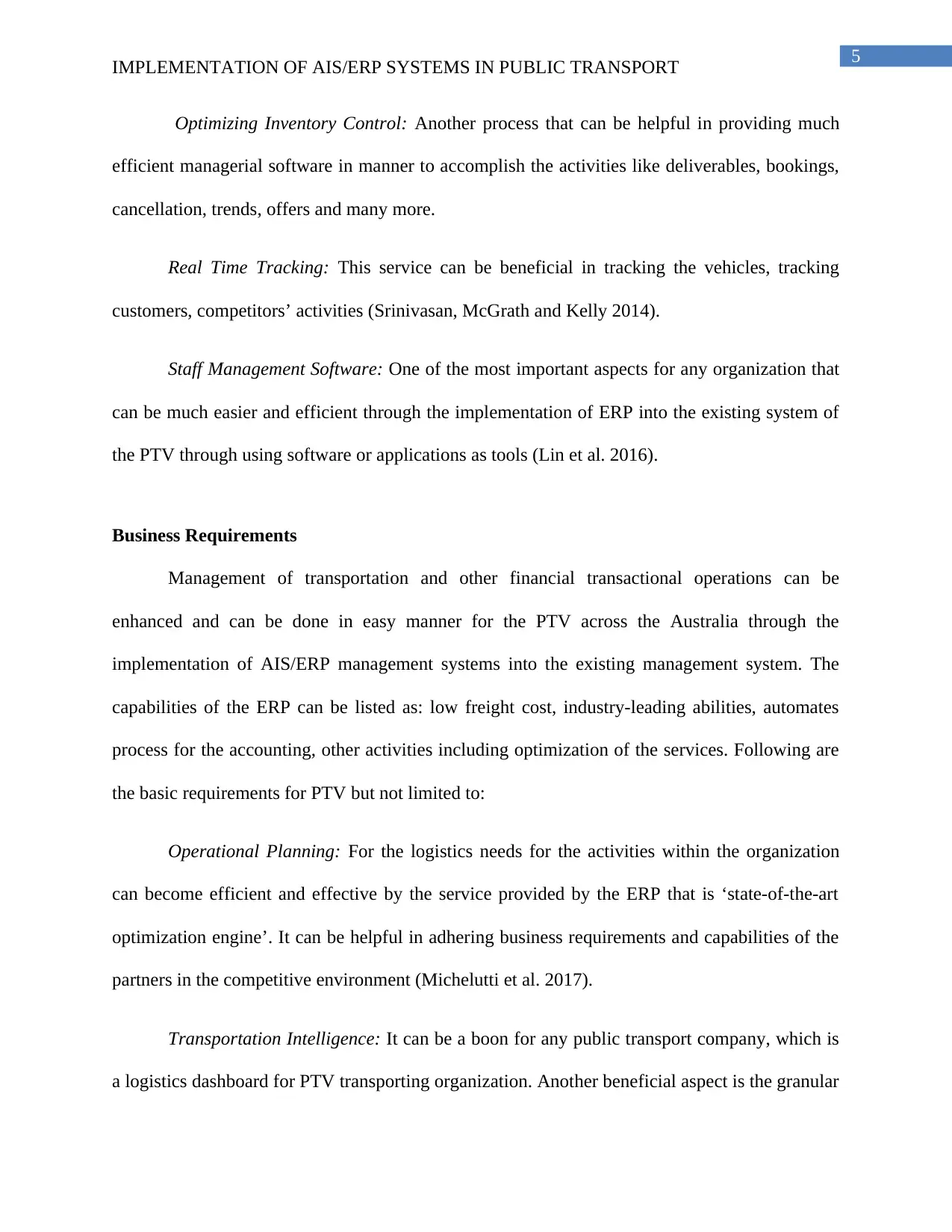
5
IMPLEMENTATION OF AIS/ERP SYSTEMS IN PUBLIC TRANSPORT
Optimizing Inventory Control: Another process that can be helpful in providing much
efficient managerial software in manner to accomplish the activities like deliverables, bookings,
cancellation, trends, offers and many more.
Real Time Tracking: This service can be beneficial in tracking the vehicles, tracking
customers, competitors’ activities (Srinivasan, McGrath and Kelly 2014).
Staff Management Software: One of the most important aspects for any organization that
can be much easier and efficient through the implementation of ERP into the existing system of
the PTV through using software or applications as tools (Lin et al. 2016).
Business Requirements
Management of transportation and other financial transactional operations can be
enhanced and can be done in easy manner for the PTV across the Australia through the
implementation of AIS/ERP management systems into the existing management system. The
capabilities of the ERP can be listed as: low freight cost, industry-leading abilities, automates
process for the accounting, other activities including optimization of the services. Following are
the basic requirements for PTV but not limited to:
Operational Planning: For the logistics needs for the activities within the organization
can become efficient and effective by the service provided by the ERP that is ‘state-of-the-art
optimization engine’. It can be helpful in adhering business requirements and capabilities of the
partners in the competitive environment (Michelutti et al. 2017).
Transportation Intelligence: It can be a boon for any public transport company, which is
a logistics dashboard for PTV transporting organization. Another beneficial aspect is the granular
IMPLEMENTATION OF AIS/ERP SYSTEMS IN PUBLIC TRANSPORT
Optimizing Inventory Control: Another process that can be helpful in providing much
efficient managerial software in manner to accomplish the activities like deliverables, bookings,
cancellation, trends, offers and many more.
Real Time Tracking: This service can be beneficial in tracking the vehicles, tracking
customers, competitors’ activities (Srinivasan, McGrath and Kelly 2014).
Staff Management Software: One of the most important aspects for any organization that
can be much easier and efficient through the implementation of ERP into the existing system of
the PTV through using software or applications as tools (Lin et al. 2016).
Business Requirements
Management of transportation and other financial transactional operations can be
enhanced and can be done in easy manner for the PTV across the Australia through the
implementation of AIS/ERP management systems into the existing management system. The
capabilities of the ERP can be listed as: low freight cost, industry-leading abilities, automates
process for the accounting, other activities including optimization of the services. Following are
the basic requirements for PTV but not limited to:
Operational Planning: For the logistics needs for the activities within the organization
can become efficient and effective by the service provided by the ERP that is ‘state-of-the-art
optimization engine’. It can be helpful in adhering business requirements and capabilities of the
partners in the competitive environment (Michelutti et al. 2017).
Transportation Intelligence: It can be a boon for any public transport company, which is
a logistics dashboard for PTV transporting organization. Another beneficial aspect is the granular
⊘ This is a preview!⊘
Do you want full access?
Subscribe today to unlock all pages.

Trusted by 1+ million students worldwide
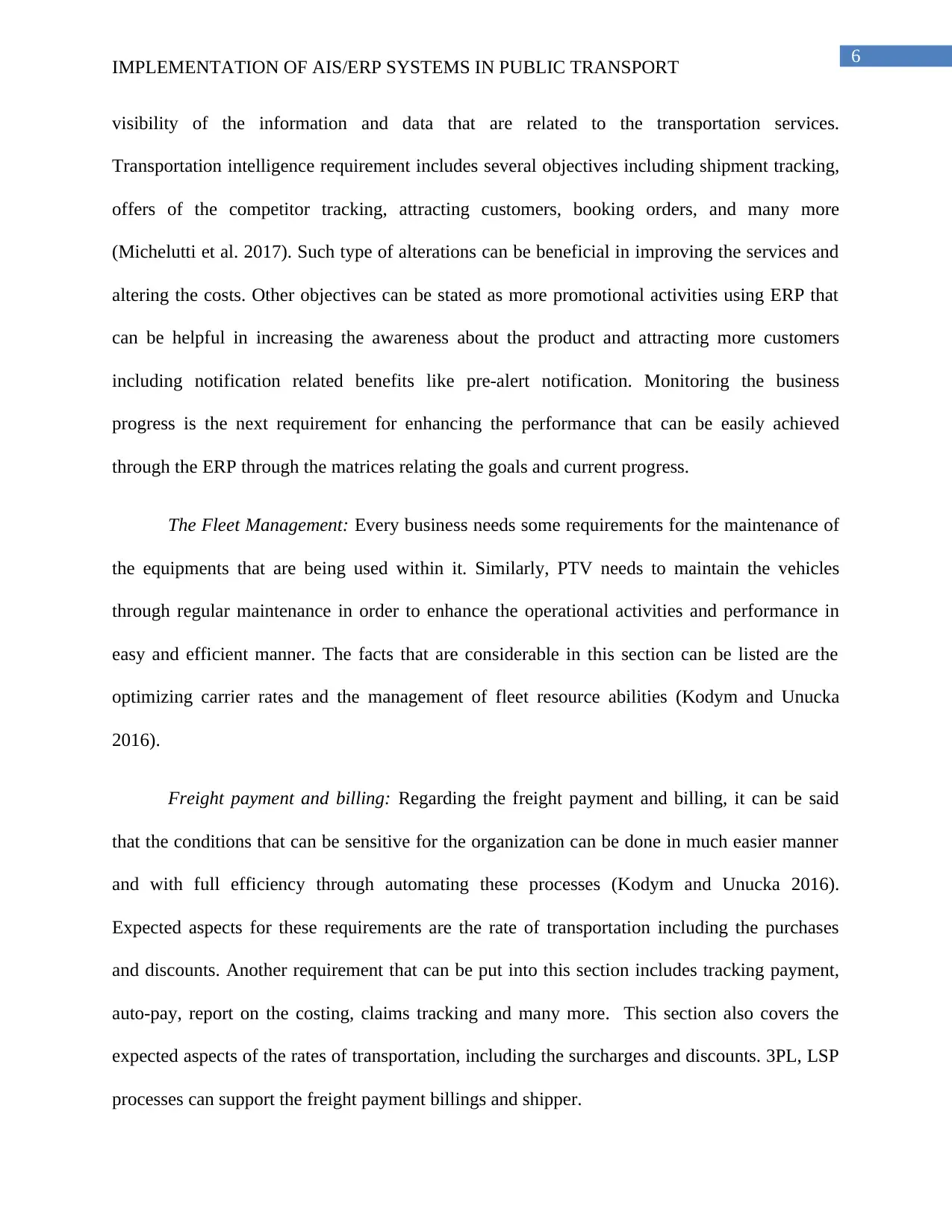
6
IMPLEMENTATION OF AIS/ERP SYSTEMS IN PUBLIC TRANSPORT
visibility of the information and data that are related to the transportation services.
Transportation intelligence requirement includes several objectives including shipment tracking,
offers of the competitor tracking, attracting customers, booking orders, and many more
(Michelutti et al. 2017). Such type of alterations can be beneficial in improving the services and
altering the costs. Other objectives can be stated as more promotional activities using ERP that
can be helpful in increasing the awareness about the product and attracting more customers
including notification related benefits like pre-alert notification. Monitoring the business
progress is the next requirement for enhancing the performance that can be easily achieved
through the ERP through the matrices relating the goals and current progress.
The Fleet Management: Every business needs some requirements for the maintenance of
the equipments that are being used within it. Similarly, PTV needs to maintain the vehicles
through regular maintenance in order to enhance the operational activities and performance in
easy and efficient manner. The facts that are considerable in this section can be listed are the
optimizing carrier rates and the management of fleet resource abilities (Kodym and Unucka
2016).
Freight payment and billing: Regarding the freight payment and billing, it can be said
that the conditions that can be sensitive for the organization can be done in much easier manner
and with full efficiency through automating these processes (Kodym and Unucka 2016).
Expected aspects for these requirements are the rate of transportation including the purchases
and discounts. Another requirement that can be put into this section includes tracking payment,
auto-pay, report on the costing, claims tracking and many more. This section also covers the
expected aspects of the rates of transportation, including the surcharges and discounts. 3PL, LSP
processes can support the freight payment billings and shipper.
IMPLEMENTATION OF AIS/ERP SYSTEMS IN PUBLIC TRANSPORT
visibility of the information and data that are related to the transportation services.
Transportation intelligence requirement includes several objectives including shipment tracking,
offers of the competitor tracking, attracting customers, booking orders, and many more
(Michelutti et al. 2017). Such type of alterations can be beneficial in improving the services and
altering the costs. Other objectives can be stated as more promotional activities using ERP that
can be helpful in increasing the awareness about the product and attracting more customers
including notification related benefits like pre-alert notification. Monitoring the business
progress is the next requirement for enhancing the performance that can be easily achieved
through the ERP through the matrices relating the goals and current progress.
The Fleet Management: Every business needs some requirements for the maintenance of
the equipments that are being used within it. Similarly, PTV needs to maintain the vehicles
through regular maintenance in order to enhance the operational activities and performance in
easy and efficient manner. The facts that are considerable in this section can be listed are the
optimizing carrier rates and the management of fleet resource abilities (Kodym and Unucka
2016).
Freight payment and billing: Regarding the freight payment and billing, it can be said
that the conditions that can be sensitive for the organization can be done in much easier manner
and with full efficiency through automating these processes (Kodym and Unucka 2016).
Expected aspects for these requirements are the rate of transportation including the purchases
and discounts. Another requirement that can be put into this section includes tracking payment,
auto-pay, report on the costing, claims tracking and many more. This section also covers the
expected aspects of the rates of transportation, including the surcharges and discounts. 3PL, LSP
processes can support the freight payment billings and shipper.
Paraphrase This Document
Need a fresh take? Get an instant paraphrase of this document with our AI Paraphraser
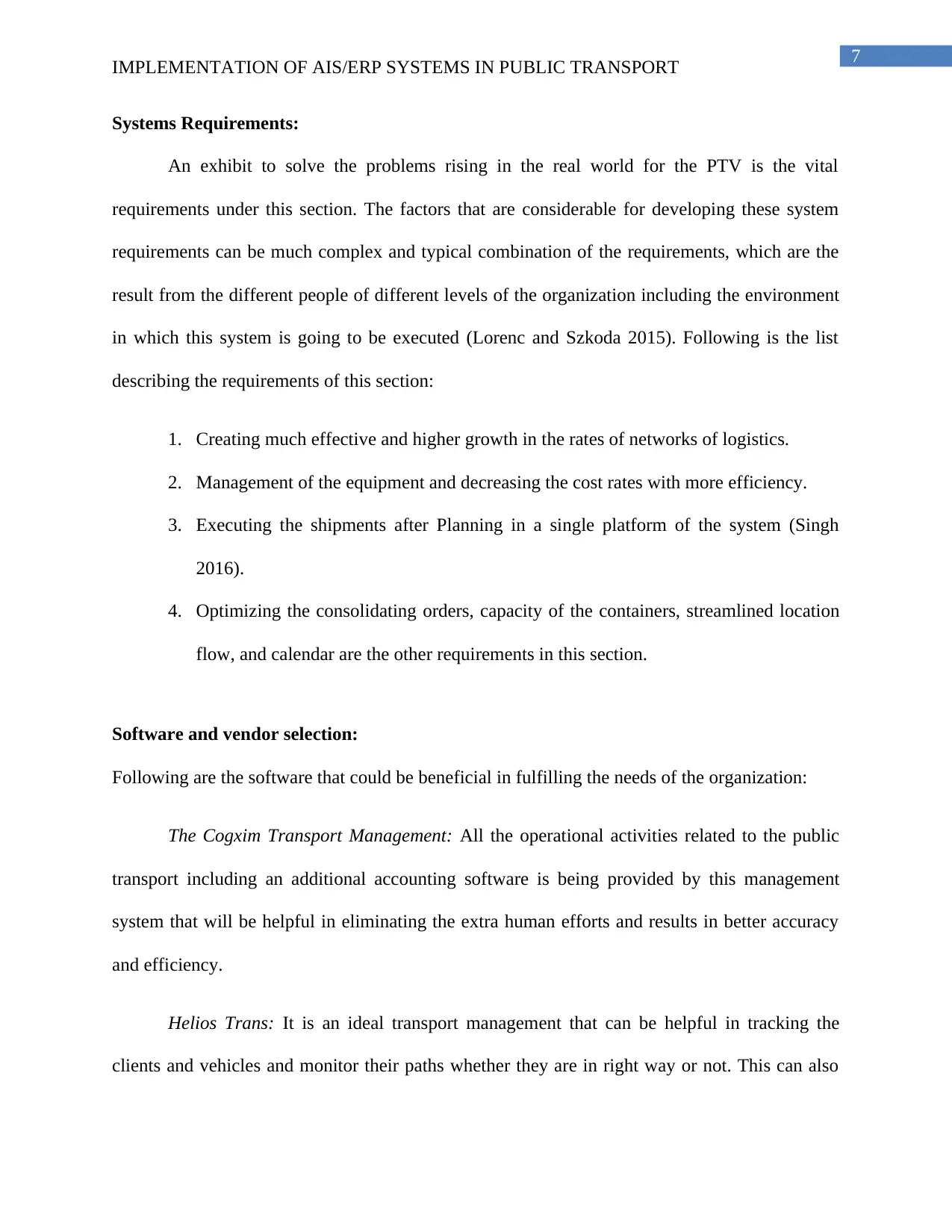
7
IMPLEMENTATION OF AIS/ERP SYSTEMS IN PUBLIC TRANSPORT
Systems Requirements:
An exhibit to solve the problems rising in the real world for the PTV is the vital
requirements under this section. The factors that are considerable for developing these system
requirements can be much complex and typical combination of the requirements, which are the
result from the different people of different levels of the organization including the environment
in which this system is going to be executed (Lorenc and Szkoda 2015). Following is the list
describing the requirements of this section:
1. Creating much effective and higher growth in the rates of networks of logistics.
2. Management of the equipment and decreasing the cost rates with more efficiency.
3. Executing the shipments after Planning in a single platform of the system (Singh
2016).
4. Optimizing the consolidating orders, capacity of the containers, streamlined location
flow, and calendar are the other requirements in this section.
Software and vendor selection:
Following are the software that could be beneficial in fulfilling the needs of the organization:
The Cogxim Transport Management: All the operational activities related to the public
transport including an additional accounting software is being provided by this management
system that will be helpful in eliminating the extra human efforts and results in better accuracy
and efficiency.
Helios Trans: It is an ideal transport management that can be helpful in tracking the
clients and vehicles and monitor their paths whether they are in right way or not. This can also
IMPLEMENTATION OF AIS/ERP SYSTEMS IN PUBLIC TRANSPORT
Systems Requirements:
An exhibit to solve the problems rising in the real world for the PTV is the vital
requirements under this section. The factors that are considerable for developing these system
requirements can be much complex and typical combination of the requirements, which are the
result from the different people of different levels of the organization including the environment
in which this system is going to be executed (Lorenc and Szkoda 2015). Following is the list
describing the requirements of this section:
1. Creating much effective and higher growth in the rates of networks of logistics.
2. Management of the equipment and decreasing the cost rates with more efficiency.
3. Executing the shipments after Planning in a single platform of the system (Singh
2016).
4. Optimizing the consolidating orders, capacity of the containers, streamlined location
flow, and calendar are the other requirements in this section.
Software and vendor selection:
Following are the software that could be beneficial in fulfilling the needs of the organization:
The Cogxim Transport Management: All the operational activities related to the public
transport including an additional accounting software is being provided by this management
system that will be helpful in eliminating the extra human efforts and results in better accuracy
and efficiency.
Helios Trans: It is an ideal transport management that can be helpful in tracking the
clients and vehicles and monitor their paths whether they are in right way or not. This can also
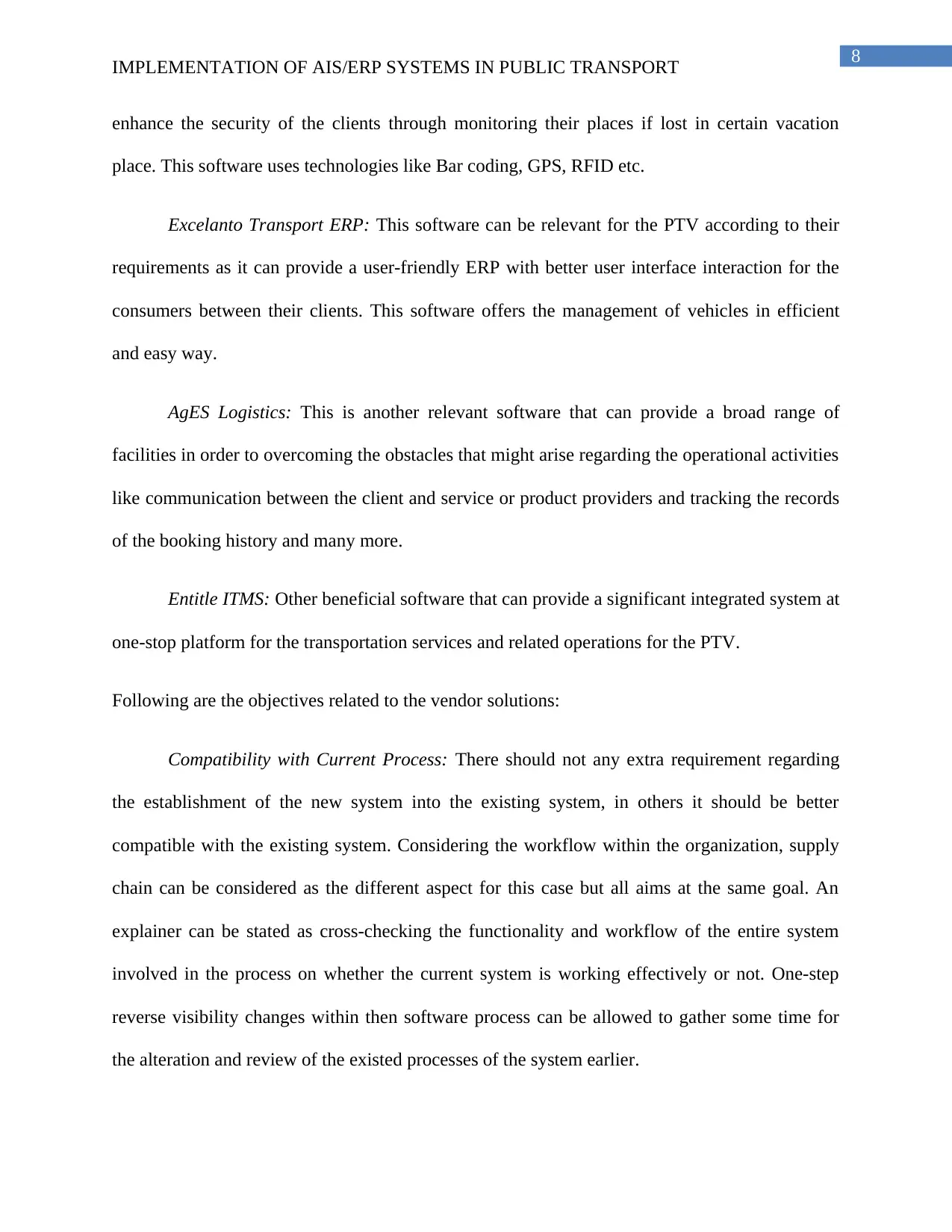
8
IMPLEMENTATION OF AIS/ERP SYSTEMS IN PUBLIC TRANSPORT
enhance the security of the clients through monitoring their places if lost in certain vacation
place. This software uses technologies like Bar coding, GPS, RFID etc.
Excelanto Transport ERP: This software can be relevant for the PTV according to their
requirements as it can provide a user-friendly ERP with better user interface interaction for the
consumers between their clients. This software offers the management of vehicles in efficient
and easy way.
AgES Logistics: This is another relevant software that can provide a broad range of
facilities in order to overcoming the obstacles that might arise regarding the operational activities
like communication between the client and service or product providers and tracking the records
of the booking history and many more.
Entitle ITMS: Other beneficial software that can provide a significant integrated system at
one-stop platform for the transportation services and related operations for the PTV.
Following are the objectives related to the vendor solutions:
Compatibility with Current Process: There should not any extra requirement regarding
the establishment of the new system into the existing system, in others it should be better
compatible with the existing system. Considering the workflow within the organization, supply
chain can be considered as the different aspect for this case but all aims at the same goal. An
explainer can be stated as cross-checking the functionality and workflow of the entire system
involved in the process on whether the current system is working effectively or not. One-step
reverse visibility changes within then software process can be allowed to gather some time for
the alteration and review of the existed processes of the system earlier.
IMPLEMENTATION OF AIS/ERP SYSTEMS IN PUBLIC TRANSPORT
enhance the security of the clients through monitoring their places if lost in certain vacation
place. This software uses technologies like Bar coding, GPS, RFID etc.
Excelanto Transport ERP: This software can be relevant for the PTV according to their
requirements as it can provide a user-friendly ERP with better user interface interaction for the
consumers between their clients. This software offers the management of vehicles in efficient
and easy way.
AgES Logistics: This is another relevant software that can provide a broad range of
facilities in order to overcoming the obstacles that might arise regarding the operational activities
like communication between the client and service or product providers and tracking the records
of the booking history and many more.
Entitle ITMS: Other beneficial software that can provide a significant integrated system at
one-stop platform for the transportation services and related operations for the PTV.
Following are the objectives related to the vendor solutions:
Compatibility with Current Process: There should not any extra requirement regarding
the establishment of the new system into the existing system, in others it should be better
compatible with the existing system. Considering the workflow within the organization, supply
chain can be considered as the different aspect for this case but all aims at the same goal. An
explainer can be stated as cross-checking the functionality and workflow of the entire system
involved in the process on whether the current system is working effectively or not. One-step
reverse visibility changes within then software process can be allowed to gather some time for
the alteration and review of the existed processes of the system earlier.
⊘ This is a preview!⊘
Do you want full access?
Subscribe today to unlock all pages.

Trusted by 1+ million students worldwide
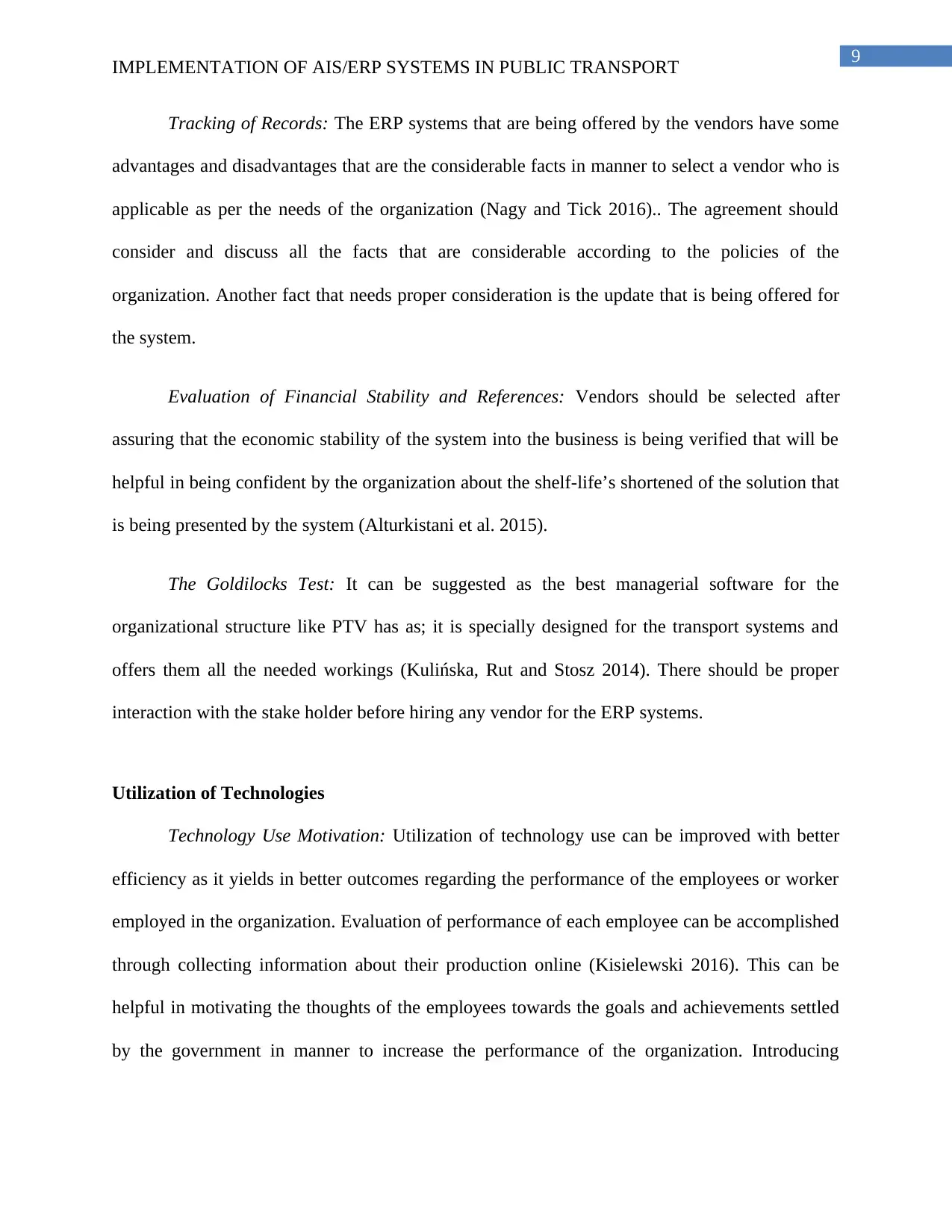
9
IMPLEMENTATION OF AIS/ERP SYSTEMS IN PUBLIC TRANSPORT
Tracking of Records: The ERP systems that are being offered by the vendors have some
advantages and disadvantages that are the considerable facts in manner to select a vendor who is
applicable as per the needs of the organization (Nagy and Tick 2016).. The agreement should
consider and discuss all the facts that are considerable according to the policies of the
organization. Another fact that needs proper consideration is the update that is being offered for
the system.
Evaluation of Financial Stability and References: Vendors should be selected after
assuring that the economic stability of the system into the business is being verified that will be
helpful in being confident by the organization about the shelf-life’s shortened of the solution that
is being presented by the system (Alturkistani et al. 2015).
The Goldilocks Test: It can be suggested as the best managerial software for the
organizational structure like PTV has as; it is specially designed for the transport systems and
offers them all the needed workings (Kulińska, Rut and Stosz 2014). There should be proper
interaction with the stake holder before hiring any vendor for the ERP systems.
Utilization of Technologies
Technology Use Motivation: Utilization of technology use can be improved with better
efficiency as it yields in better outcomes regarding the performance of the employees or worker
employed in the organization. Evaluation of performance of each employee can be accomplished
through collecting information about their production online (Kisielewski 2016). This can be
helpful in motivating the thoughts of the employees towards the goals and achievements settled
by the government in manner to increase the performance of the organization. Introducing
IMPLEMENTATION OF AIS/ERP SYSTEMS IN PUBLIC TRANSPORT
Tracking of Records: The ERP systems that are being offered by the vendors have some
advantages and disadvantages that are the considerable facts in manner to select a vendor who is
applicable as per the needs of the organization (Nagy and Tick 2016).. The agreement should
consider and discuss all the facts that are considerable according to the policies of the
organization. Another fact that needs proper consideration is the update that is being offered for
the system.
Evaluation of Financial Stability and References: Vendors should be selected after
assuring that the economic stability of the system into the business is being verified that will be
helpful in being confident by the organization about the shelf-life’s shortened of the solution that
is being presented by the system (Alturkistani et al. 2015).
The Goldilocks Test: It can be suggested as the best managerial software for the
organizational structure like PTV has as; it is specially designed for the transport systems and
offers them all the needed workings (Kulińska, Rut and Stosz 2014). There should be proper
interaction with the stake holder before hiring any vendor for the ERP systems.
Utilization of Technologies
Technology Use Motivation: Utilization of technology use can be improved with better
efficiency as it yields in better outcomes regarding the performance of the employees or worker
employed in the organization. Evaluation of performance of each employee can be accomplished
through collecting information about their production online (Kisielewski 2016). This can be
helpful in motivating the thoughts of the employees towards the goals and achievements settled
by the government in manner to increase the performance of the organization. Introducing
Paraphrase This Document
Need a fresh take? Get an instant paraphrase of this document with our AI Paraphraser
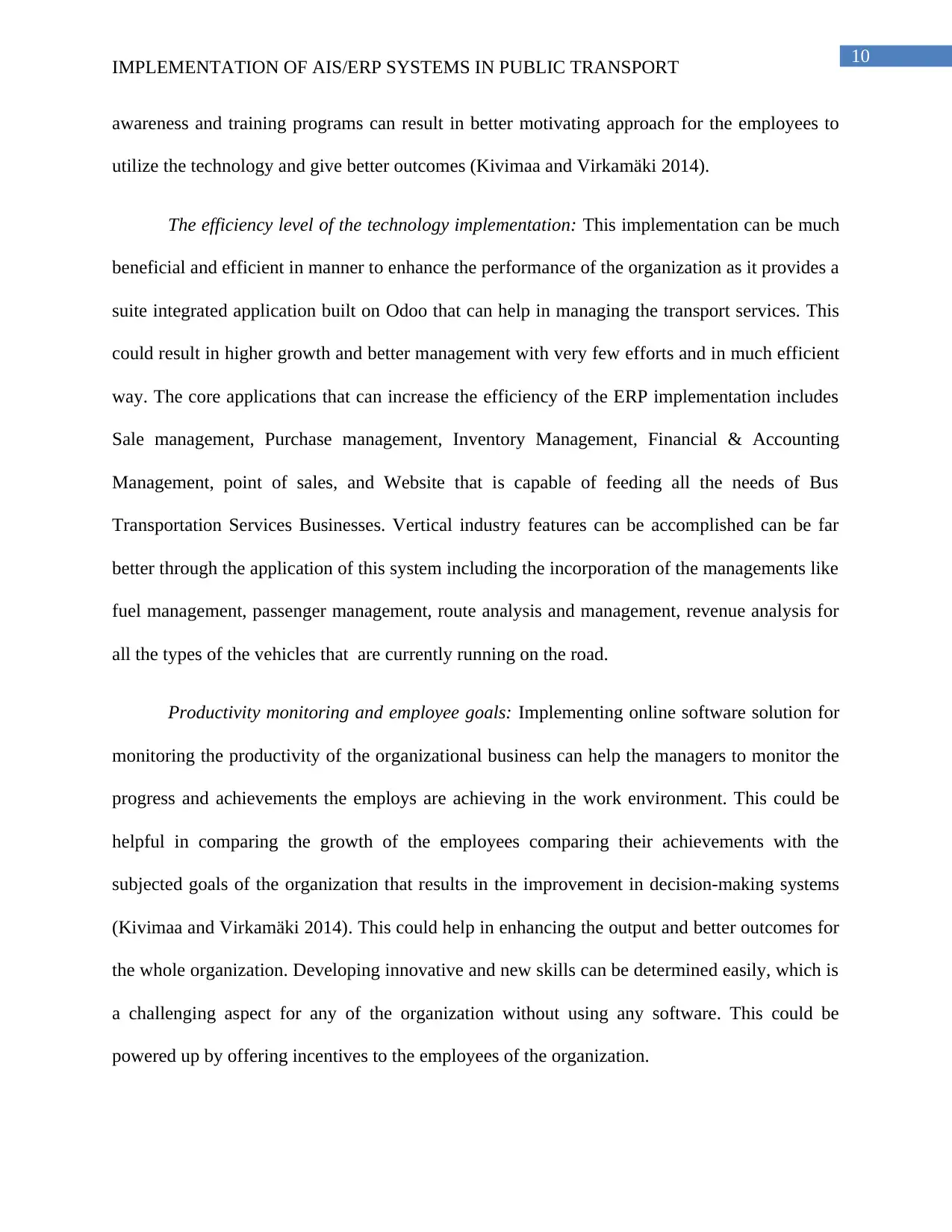
10
IMPLEMENTATION OF AIS/ERP SYSTEMS IN PUBLIC TRANSPORT
awareness and training programs can result in better motivating approach for the employees to
utilize the technology and give better outcomes (Kivimaa and Virkamäki 2014).
The efficiency level of the technology implementation: This implementation can be much
beneficial and efficient in manner to enhance the performance of the organization as it provides a
suite integrated application built on Odoo that can help in managing the transport services. This
could result in higher growth and better management with very few efforts and in much efficient
way. The core applications that can increase the efficiency of the ERP implementation includes
Sale management, Purchase management, Inventory Management, Financial & Accounting
Management, point of sales, and Website that is capable of feeding all the needs of Bus
Transportation Services Businesses. Vertical industry features can be accomplished can be far
better through the application of this system including the incorporation of the managements like
fuel management, passenger management, route analysis and management, revenue analysis for
all the types of the vehicles that are currently running on the road.
Productivity monitoring and employee goals: Implementing online software solution for
monitoring the productivity of the organizational business can help the managers to monitor the
progress and achievements the employs are achieving in the work environment. This could be
helpful in comparing the growth of the employees comparing their achievements with the
subjected goals of the organization that results in the improvement in decision-making systems
(Kivimaa and Virkamäki 2014). This could help in enhancing the output and better outcomes for
the whole organization. Developing innovative and new skills can be determined easily, which is
a challenging aspect for any of the organization without using any software. This could be
powered up by offering incentives to the employees of the organization.
IMPLEMENTATION OF AIS/ERP SYSTEMS IN PUBLIC TRANSPORT
awareness and training programs can result in better motivating approach for the employees to
utilize the technology and give better outcomes (Kivimaa and Virkamäki 2014).
The efficiency level of the technology implementation: This implementation can be much
beneficial and efficient in manner to enhance the performance of the organization as it provides a
suite integrated application built on Odoo that can help in managing the transport services. This
could result in higher growth and better management with very few efforts and in much efficient
way. The core applications that can increase the efficiency of the ERP implementation includes
Sale management, Purchase management, Inventory Management, Financial & Accounting
Management, point of sales, and Website that is capable of feeding all the needs of Bus
Transportation Services Businesses. Vertical industry features can be accomplished can be far
better through the application of this system including the incorporation of the managements like
fuel management, passenger management, route analysis and management, revenue analysis for
all the types of the vehicles that are currently running on the road.
Productivity monitoring and employee goals: Implementing online software solution for
monitoring the productivity of the organizational business can help the managers to monitor the
progress and achievements the employs are achieving in the work environment. This could be
helpful in comparing the growth of the employees comparing their achievements with the
subjected goals of the organization that results in the improvement in decision-making systems
(Kivimaa and Virkamäki 2014). This could help in enhancing the output and better outcomes for
the whole organization. Developing innovative and new skills can be determined easily, which is
a challenging aspect for any of the organization without using any software. This could be
powered up by offering incentives to the employees of the organization.
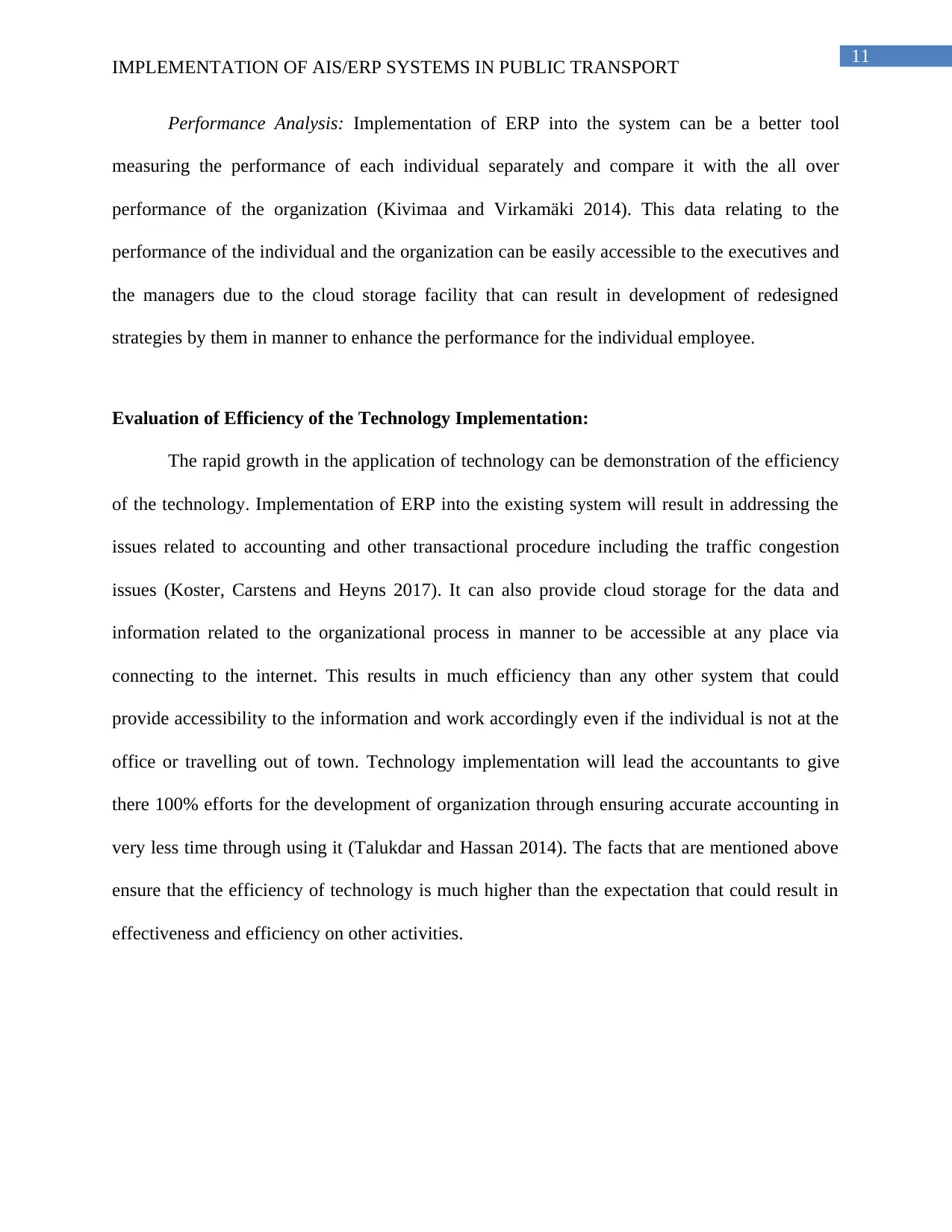
11
IMPLEMENTATION OF AIS/ERP SYSTEMS IN PUBLIC TRANSPORT
Performance Analysis: Implementation of ERP into the system can be a better tool
measuring the performance of each individual separately and compare it with the all over
performance of the organization (Kivimaa and Virkamäki 2014). This data relating to the
performance of the individual and the organization can be easily accessible to the executives and
the managers due to the cloud storage facility that can result in development of redesigned
strategies by them in manner to enhance the performance for the individual employee.
Evaluation of Efficiency of the Technology Implementation:
The rapid growth in the application of technology can be demonstration of the efficiency
of the technology. Implementation of ERP into the existing system will result in addressing the
issues related to accounting and other transactional procedure including the traffic congestion
issues (Koster, Carstens and Heyns 2017). It can also provide cloud storage for the data and
information related to the organizational process in manner to be accessible at any place via
connecting to the internet. This results in much efficiency than any other system that could
provide accessibility to the information and work accordingly even if the individual is not at the
office or travelling out of town. Technology implementation will lead the accountants to give
there 100% efforts for the development of organization through ensuring accurate accounting in
very less time through using it (Talukdar and Hassan 2014). The facts that are mentioned above
ensure that the efficiency of technology is much higher than the expectation that could result in
effectiveness and efficiency on other activities.
IMPLEMENTATION OF AIS/ERP SYSTEMS IN PUBLIC TRANSPORT
Performance Analysis: Implementation of ERP into the system can be a better tool
measuring the performance of each individual separately and compare it with the all over
performance of the organization (Kivimaa and Virkamäki 2014). This data relating to the
performance of the individual and the organization can be easily accessible to the executives and
the managers due to the cloud storage facility that can result in development of redesigned
strategies by them in manner to enhance the performance for the individual employee.
Evaluation of Efficiency of the Technology Implementation:
The rapid growth in the application of technology can be demonstration of the efficiency
of the technology. Implementation of ERP into the existing system will result in addressing the
issues related to accounting and other transactional procedure including the traffic congestion
issues (Koster, Carstens and Heyns 2017). It can also provide cloud storage for the data and
information related to the organizational process in manner to be accessible at any place via
connecting to the internet. This results in much efficiency than any other system that could
provide accessibility to the information and work accordingly even if the individual is not at the
office or travelling out of town. Technology implementation will lead the accountants to give
there 100% efforts for the development of organization through ensuring accurate accounting in
very less time through using it (Talukdar and Hassan 2014). The facts that are mentioned above
ensure that the efficiency of technology is much higher than the expectation that could result in
effectiveness and efficiency on other activities.
⊘ This is a preview!⊘
Do you want full access?
Subscribe today to unlock all pages.

Trusted by 1+ million students worldwide
1 out of 20
Related Documents
Your All-in-One AI-Powered Toolkit for Academic Success.
+13062052269
info@desklib.com
Available 24*7 on WhatsApp / Email
![[object Object]](/_next/static/media/star-bottom.7253800d.svg)
Unlock your academic potential
Copyright © 2020–2025 A2Z Services. All Rights Reserved. Developed and managed by ZUCOL.





